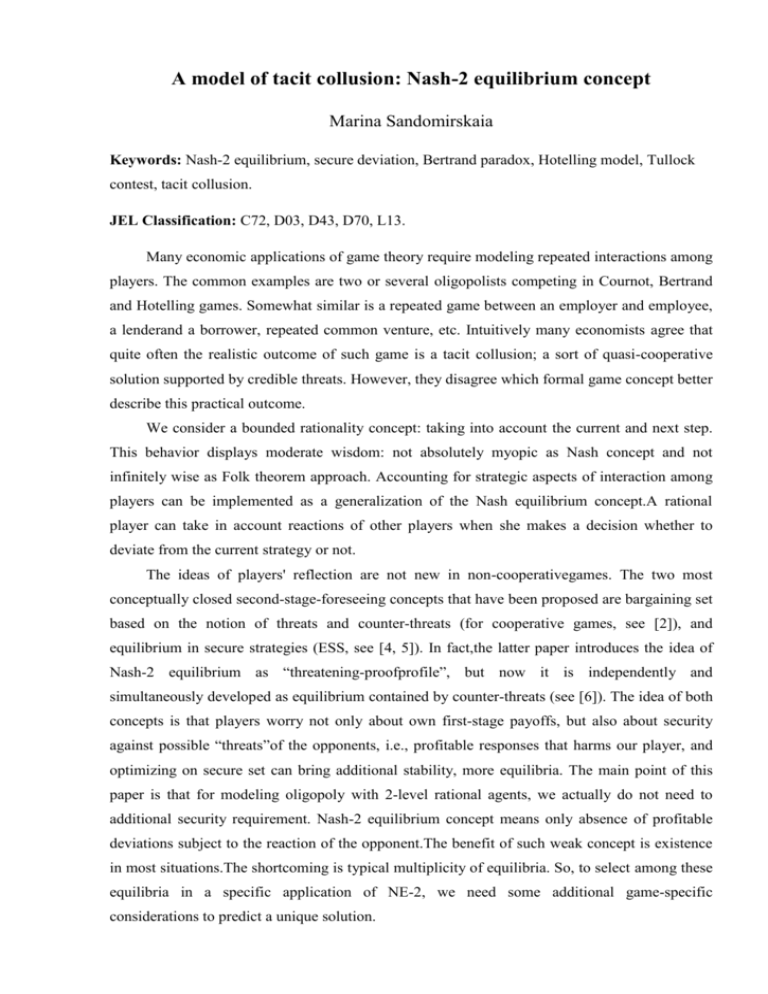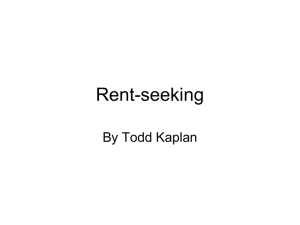A model of tacit collusion: Nash
advertisement

A model of tacit collusion: Nash-2 equilibrium concept
Marina Sandomirskaia
Keywords: Nash-2 equilibrium, secure deviation, Bertrand paradox, Hotelling model, Tullock
contest, tacit collusion.
JEL Classification: C72, D03, D43, D70, L13.
Many economic applications of game theory require modeling repeated interactions among
players. The common examples are two or several oligopolists competing in Cournot, Bertrand
and Hotelling games. Somewhat similar is a repeated game between an employer and employee,
a lenderand a borrower, repeated common venture, etc. Intuitively many economists agree that
quite often the realistic outcome of such game is a tacit collusion; a sort of quasi-cooperative
solution supported by credible threats. However, they disagree which formal game concept better
describe this practical outcome.
We consider a bounded rationality concept: taking into account the current and next step.
This behavior displays moderate wisdom: not absolutely myopic as Nash concept and not
infinitely wise as Folk theorem approach. Accounting for strategic aspects of interaction among
players can be implemented as a generalization of the Nash equilibrium concept.A rational
player can take in account reactions of other players when she makes a decision whether to
deviate from the current strategy or not.
The ideas of players' reflection are not new in non-cooperativegames. The two most
conceptually closed second-stage-foreseeing concepts that have been proposed are bargaining set
based on the notion of threats and counter-threats (for cooperative games, see [2]), and
equilibrium in secure strategies (ESS, see [4, 5]). In fact,the latter paper introduces the idea of
Nash-2 equilibrium as “threatening-proofprofile”, but now it is independently and
simultaneously developed as equilibrium contained by counter-threats (see [6]). The idea of both
concepts is that players worry not only about own first-stage payoffs, but also about security
against possible “threats”of the opponents, i.e., profitable responses that harms our player, and
optimizing on secure set can bring additional stability, more equilibria. The main point of this
paper is that for modeling oligopoly with 2-level rational agents, we actually do not need to
additional security requirement. Nash-2 equilibrium concept means only absence of profitable
deviations subject to the reaction of the opponent.The benefit of such weak concept is existence
in most situations.The shortcoming is typical multiplicity of equilibria. So, to select among these
equilibria in a specific application of NE-2, we need some additional game-specific
considerations to predict a unique solution.
Let us give the formal definition of NE-2 equilibrium in a 2-person non-cooperative game
in the normal form 𝐺 = (𝑖 ∈ {1,2}, 𝑠𝑖 ∈ 𝑆𝑖 , 𝑢𝑖 : 𝑆1 × 𝑆2 → 𝑹).
Definition.A profitable deviation 𝑠′𝑖 of player 𝑖 at strategy profile 𝑠 = (𝑠𝑖 , 𝑠−𝑖 ) (i.e. 𝑢𝑖 (𝑠′𝑖 , 𝑠−𝑖 ) >
𝑢𝑖 (𝑠𝑖 , 𝑠−𝑖 )) is secure if for any profitable strategy 𝑠′−𝑖 of player −𝑖 (i.e. 𝑢−𝑖 (𝑠′𝑖 , 𝑠′−𝑖 ) >
𝑢−𝑖 (𝑠′𝑖 , 𝑠−𝑖 )) our player 𝑖 is not worse off:
𝑢𝑖 (𝑠′𝑖 , 𝑠′−𝑖 ) > 𝑢𝑖 (𝑠𝑖 , 𝑠−𝑖 ).
A strategy profile is a Nash-2 equilibrium (NE-2) if no player has a profitable secure deviation.
NE-2 concept seems to be a reasonable outcome in a repeated game. Such 2-stage
rationality is one of the possible compromises between zero rationality of NE and infinite
rationality of Folk theorem. Obviously, NE-2 may be not secure. Indeed, when NE-2 includes a
threat from one player to another nobody actualizes her threats because they are not secure
deviations for her. We can regard it as an analogue of the bargaining set in cooperative games.
Note that accounting for the responses of the opponents play a role of tacit communication
between players. The result of such approach looks like a tacit collusion between agents.
In the paper we define Nash equilibrium, equilibrium in secure strategies and Nash-2
equilibrium in terms of deviations, threats,and security, and illustrate the concepts with some
simple examples.
We provide a condition for existence of Nash-2 equilibrium in a two-person game and
demonstrate that NE-2 exists “almost always” (without strictly defining this notion). In other
words, whenever a game does not have NE-2, any small “perturbation” of payoffs yields NE-2
existence.
We apply the new concept to a number of classical economics models: Bertrand and
Cournot duopolies, Hotelling model, Tullock contest, and show that Nash-2 concept can provide
a strategic explanation for possible collusion between firms.
References
[1]
d’Aspremont C., Gabszewicz J., Thisse J.-F. OnHotelling’s “Stability in Competition”.
Econometrica. 1979. Vol.47. No. 5. P. 1145-1150.
[2]
Aumann R.J., Maschler M. The bargaining set for cooperative games.Advanced in game
theory. 1964. Vol. 52.P. 443-476.
[3]
Iskakov M., Iskakov A. Complete solutionof the Hotelling problem: equilibrium in secure
strategies for theprice subgame..Journal of New Economic Association. 2012. No.
1(13).P.10-33. (in Russian)
[4]
Iskakov M., Iskakov A. Equilibrium in secure strategies.CORE Discussion Paper 2012/61.
37 p.
[5]
Iskakov M., Iskakov A. Equilibrium in securestrategies – intuitive formulation.Working
paper WP7/2012/06.Math. methods for decision making in economics, business and
politics.2012. 52 p.
[6]
Iskakov M., Iskakov A. Equilibrium containedby counter-threats and complex equilibrium
in secure strategies.Large scale systems control. 2014. Vol. 51. P. 130-157. (in Russian)
[7]
Iskakov M., Iskakov A., Zakharov A. Tullock rent-seeking contest and its solution insecure
strategies. Working paper WP7/2013/01. Math. methods for decision making in economics,
business and politics. 2013. 45 p.
[8]
Sandomirskaia M. A model of tacit collusion: Nash-2 equilibrium concept. Basic Research
Program. Working Papers. Series: Economics (to appear).









